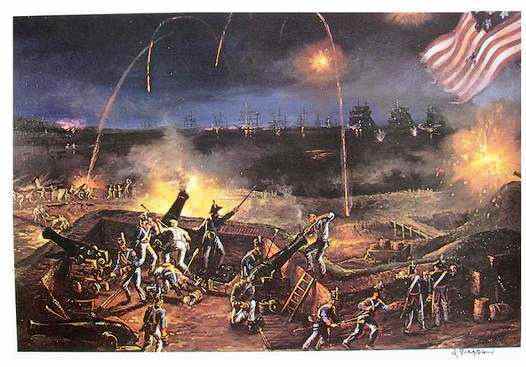Americans,*
On the fourth of July, we celebrate not merely the birth of our nation, but our common Declaration that God, the author of liberty, has given to us inalienable rights. And so today we give thanks for God’s providence which forged and guided our nation for the protection of these rights.
But today, I would like to recall another event in American history of equal importance, when our people proved that these great principles were not merely worthy of declaration but also of defense. On September 13, 1814, the people of Baltimore repelled a great British invasion and proved to the world that this fledgling nation would no longer be fettered by the tyranny of Britain. This battle inspired Francis Scott Key to pen the lyrics to The Star Spangled Banner.
 During the War of 1812, the British sought to re-establish its control over the United States. Operating from naval bases at Bermuda and Halifax, they blockaded American ports and conducted raids on our cities. They formed alliances with the Indians in order to attack settlers on the frontier. Despite the British attacks, The United States Secretary of War, Jay Armstrong, insisted Britain would not attack Washington since it was felt to be of little strategic importance to the British. While Congress did declare war on England, they failed to fund a war machine or to raise a substantial army.
During the War of 1812, the British sought to re-establish its control over the United States. Operating from naval bases at Bermuda and Halifax, they blockaded American ports and conducted raids on our cities. They formed alliances with the Indians in order to attack settlers on the frontier. Despite the British attacks, The United States Secretary of War, Jay Armstrong, insisted Britain would not attack Washington since it was felt to be of little strategic importance to the British. While Congress did declare war on England, they failed to fund a war machine or to raise a substantial army.
On the other hand, the people of Baltimore were well aware of the British threat. In contrast to Washington which was unable or unwilling to raise money for its defense, Baltimore raised a half a million dollars for the construction of Fort McHenry and its armaments; Additionally its citizens held regular defense drills. While Washington remained defenseless, Baltimore became vigilant.
On Aug. 24, 1814, three weeks before the battle of Baltimore, forty-five hundred British regulars, commanded by General Ross marched on Washington, DC. The Americans met them with a force of sixty-five hundred poorly trained militia at the town of Bladensburg. What followed was a hasty and disorganized retreat known as “the Bladensburg races”. Some have referred to this as the “greatest disgrace to American arms”. The real disgrace was that Washington did not regard the true threat of Britain. This miscalculation resulted in the burning of Washington, DC.
Encouraged by the easy victory over Washington, General Ross decided to attack Baltimore. On September 12, 1814, roughly 5,000 British troops landed on the north shore of the Patapsco river and marched toward Baltimore intent on capturing Fort McHenry. Meanwhile, the British fleet was to bombard the fort from sea. The ground force was met at North Point with only two thousand well-trained American militia, eager to defend our nation. Despite being outnumbered, the Americans slowed the advance of the British. The British decided to make camp for the night and wait for the sea bombardment.
It was here that General Ross was shot and killed by two youths, Daniel Wells and Henry G. McComas, the youngest of whom was only fourteen. They were in turn were killed by the British. A monument in their name now stands at North Point.
The following morning, Sept. 13th, the sea bombardment of Fort McHenry commenced. While the ground forces were certainly encouraged by the sound of the bombardment, American reinforcements had arrived, and the British now faced a force of 12,000 American militia—a number in excess of a quarter of the population of Baltimore. This proved to be an impenetrable force to the British.
Throughout the day and night British naval forces bombarded Fort McHenry with an estimated 1500 to 1800 bombs. At one point a bomb hit the Fort’s powder house but providentially it failed to explode. If it had, the Fort and Baltimore would have likely been destroyed. Despite the heavy attack, the fort stood strong and amazingly only four Americans were killed in the attack.
In the morning, the Americans hoisted over the fort an enormous oversized American flag measuring 30 by 40 ft. It stars and stripe could be seen for miles, gave courage to the Americans, and may have discouraged the British into a retreat. This sight inspired Francis Scott Key to raise the question:
“O! say does that Star-Spangled Banner Yet Wave, O’er the land of the free and the home of the brave?”
Today, all Americans should consider this question. Can we say that we are a free nation, established upon the belief of God-given rights when we are not willing to defend our founding principles? Are we to entrust our God-given liberties to Washington leaders who disregard foreign and domestic threats, demean our nation in the face of our enemies, demoralize our troops, and now seek to disarm our people?
I hope that you will be inspired by this story of Baltimore and commit yourself to the defense of our country and its principles.
Sincerely,
Sen. David Hartsuch, MD
- From an e-mail sent by former State Senator David Hartsuch, MD. Sen. Hartsuch now serves on the Republican State Central committee. Image imparted by us.

And today Baltimore’s proud legacy is preserved and enhanced by the patriotic leadership of Mayor Stephanie Rawlings-Blake…another inspiring story.